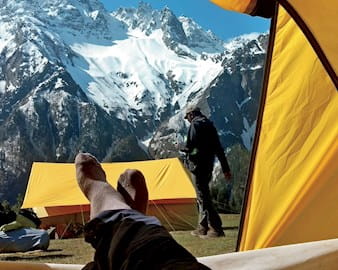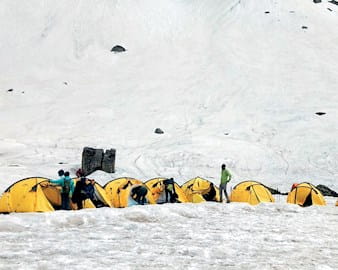
Laxmikant Pathak, ’06, renews his motivation by taking weeklong treks in the Himalayas.
- By
- October 10, 2019
- Global


No moment matches the thrill of rappelling in waist-deep snow down a curved mountain wall, 15,000 feet above sea level, that straddles a pass cutting through the Himalayan range. At least not for Laxmikant Pathak, ’06, who did all that and more during May 2019, when he undertook a weeklong Buran Ghati trek in the northern Himalayas, along a well-known but rigorous route famed for the varied array of experiences it offers—cutting through forests, grasslands, mountains, and villages still free from the trappings of modern life.
It was two years ago that Pathak, who studied in Booth’s Evening MBA Program, got back to trekking after a long hiatus during which work and family life took over. His first-ever trek was as an eighth grader with India’s National Cadet Corps to the Gangotri Glacier in the Himalayas. A six-day trek, the Gangotri-Gaumukh involves travel to and from base camp and then a final trek to a glacier 14,000 feet above sea level. The experience laid the foundation for a lifelong love for trekking and rock climbing.
His trekking journey continued during his undergrad days at Indian Institute of Technology Bombay, when information on trails and train or bus routes came only from fellow trekkers or rare guidebooks. But intrepid trekkers in the Sahyadri ranges that rise from India’s western coast could chance upon nearly pristine landscapes of lush green mountains, paddy fields, and bounteous waterfalls.
In the United States as a graduate student, first at Iowa State University and then at Chicago Booth, Pathak, whose friends called him L. P., had less opportunity and time to dedicate to treks, and instead channelled his athletic bent into playing tennis and volleyball and running half marathons. But in 2010 he moved to Bangalore, India’s tech hub with a thriving outdoors culture. Pathak is currently with GE Digital to develop its A.I. and machine-learning platform—his work cuts across three time zones. But the old hobby was calling his name. “I felt if I didn’t do it now, in a few years I would be too old to do it ever,” Pathak said. After revisiting the Gangotri-Gaumukh trek, Pathak undertook a gentle trek to the crescent-shaped Har Ki Dun Valley in May 2018.

The Buran Ghati trek this year was anything but gentle. It snowed unusually heavily on May 11, the day Pathak’s group was to set off, burying the campsites along the route deep in snow. Two previous batches of trekkers had to return without reaching the summit. Pathak’s group started climbing at 2:45 a.m.—well before sunrise—to avoid having to trek in melting snow. Even then they were unsure whether they would make it. Their work was far from done when they reached the top. From the summit, it was a 200-meter rappelling descent, followed by four further snow slides.
Trekking helps him renew his drive at work, and in life, Pathak said. “Trekking needs plenty of preparation, and complete focus on the task at hand, without too much worrying about the long-term journey,” he said. “Trekking also requires physical and mental fitness to deal with bad weather and unplanned changes. It requires you to work as a team and teaches you how to build a strong bond with your fellow mountaineers.”
He is keen to take time out for a weeklong trek in the Himalayas every summer. He hopes to do a serious trek with his wife and two children soon, and then to travel across India with his wife once their children have left for college. “India has so much geographical diversity—high-altitude peaks, deserts, national forests, beaches, and rainforests,” he said. He remains attracted to the more daring feats: another item on his bucket list? Skydiving. “I hope I will find the courage to do it someday,” he said.

The pharma executive at Pfizer is serious about changing lives and fostering new breakthroughs.
The Book of Booth: Andy Schmeltz, ’97
The LEGO Group global chief product and marketing officer reflects on what she’s learned after years of working with innovative brands—touching on agility, authenticity, and more.
Book of Booth with Julia Goldin
Amid a career dedicated to addressing energy challenges, Julie McLaughlin, ’13 (XP-82), is adding a new title to her resume: novelist.
Science Meets Fiction for an Alumna Novelist